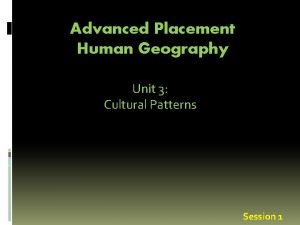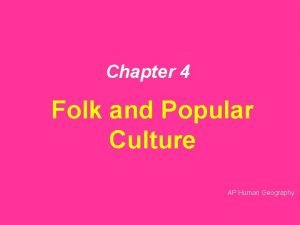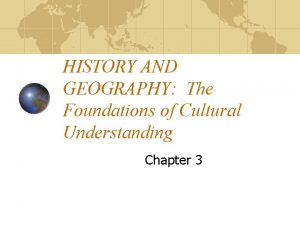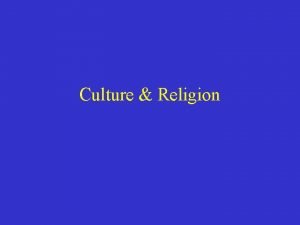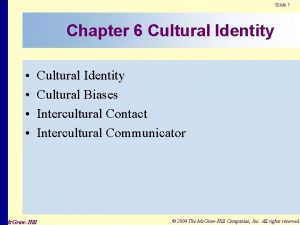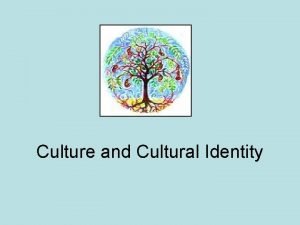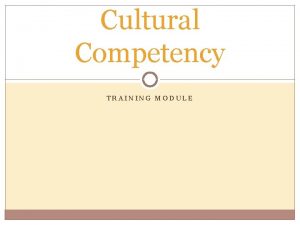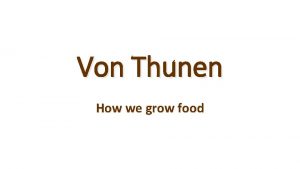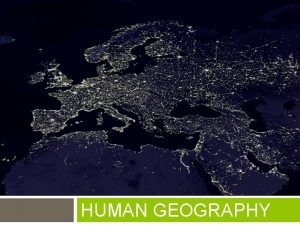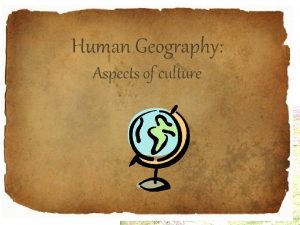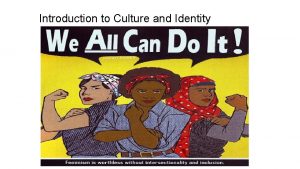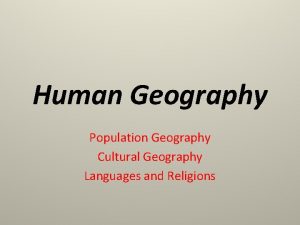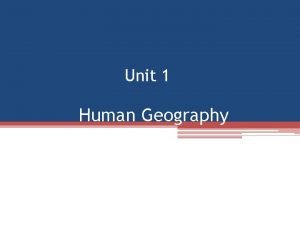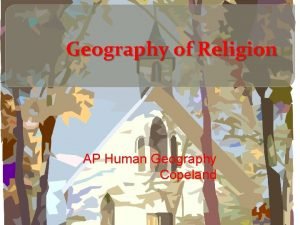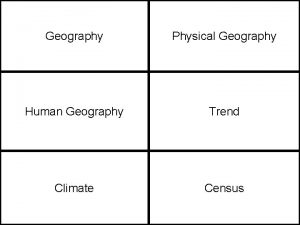AP Human Geography Review Culture and Identity CULTURE













- Slides: 13

AP Human Geography Review: Culture and Identity

CULTURE A culture is a group of belief systems, norms, and values practiced by a people. A group of people who share common beliefs can be recognized as a culture in one of two ways 1. The people call themselves a culture 2. Other people can label a certain group as a culture.

Folk Culture Stable and close knit Usually a rural community Tradition controls Resistance to change Buildings erected without architect or blueprint using locally available building materials anonymous origins, diffuses slowly through migration. Develops over time. Clustered distributions: isolation/lack of interaction breed uniqueness and ties to physical environment.

Local Culture • Folk Culture can often be limiting because it requires us to create a list of traits and to look for cultures that meet those traits. • How the people define themselves is much more important than the list of traits that is used to categorize them. • A local culture is a group of people in a particular place who see themselves as a collective community. They share experiences, customs, traits, and work to preserve customs and traits in order to claim uniqueness and distinguish themselves from others.

Popular Culture Wide Distribution: differences from place to place uncommon, more likely differences at one place over time. Housing: only small regional variations, more generally there are trends over time Food: franchises, cargo planes, superhighways and freezer trucks have eliminated much local variation. Limited variations in choice regionally, esp. with alcohol and snacks. Substantial variations by ethnicity.

Popular Culture Clothing: Jeans, for example, and have become valuable status symbols in many regions including Asia and Russia despite longstanding folk traditions.

Diffusion: When a cultural trait is introduced and spreads to other areas. Often times a cultural trait can be traced to a specific place or time, other cultural traits develop simultaneously in different areas as Independent invention. Expansion Diffusion: When an innovation or ideas develops in a hearth and remains strong there while also spreading outward contagious hierarchical Stimulus

Diffusion: Relocation Unlike expansion diffusion where the idea or innovation moves, Relocation diffusion occurs when people who have adopted the innovation or idea physically move to a new location where they then disseminate it

Cultural Hearths The seven original culture hearths are: 1) The Nile River Valley 2) The Indus River Valley 3) The Wei-Huang Valley 4) The Ganges River Valley 5) Mesopotamia 6) Mesoamerica 7) West Africa

Popular Culture Effects on Landscape: creates homogenous, “placeless” (Relph, 1976), landscape Complex network of roads and highways · Commercial Structures tend towards ‘boxes’ · Dwellings may be aesthetically suggestive of older folk traditions Planned and Gated Communities more and more common ·

Problems with the Globalization of Popular Culture Western Media Imperialism? · U. S. , Britain, and Japan dominate worldwide media. · Glorified consumerism, violence, sexuality, and militarism? · U. S. (Networks and CNN) and British (BBC) news media provide/control the dissemination of information worldwide. · These networks are unlikely to focus or provide third world perspective on issues important in the LDCs.

Environmental Problems with Cultural Globalization Accelerated Resource Use through Accelerated Consumption · · · Furs: minx, lynx, jaguar, kangaroo, whale, sea otters (18 th Century Russians) fed early fashion trends. Consumerism evident in most Western Media fashions, including hip hop and rock and roll. Inefficient over-consumption of Meats (10: 1), Poultry (3: 1), even Fish (fed other fish and chicken) by meat-eating pop cultures Mineral Extraction for Machines, Plastics and Fuel New larger housing desires and associated energy and water use. Golf courses use valuable water and destroy habitat worldwide. Pollution: waste from fuel generation and discarded products, plastics, marketing and packaging materials

What is ethnicity? How is it different than race? 1. identity with a group of people who share the cultural traditions of a particular homeland or hearth. Thus: customs, cultural characteristics, language, common history, homeland, etc. . . 2. a socially created system of rules about who belongs and who does not belong to a particular group based on actual or perceived commonality of origin, race, culture. This notion is clearly tied to place. Mongolian Japanese Kazakh Turkish Puerto Rican Thai Armenian Chinese
 Folk culture ap human geography
Folk culture ap human geography Frq examples ap human geography
Frq examples ap human geography 5 themes of geography ap human geography
5 themes of geography ap human geography Stateless nation
Stateless nation Migrant diffusion
Migrant diffusion Popular culture definition ap human geography
Popular culture definition ap human geography Gni definition ap human geography
Gni definition ap human geography Identity mapping activity
Identity mapping activity History and geography the foundations of culture
History and geography the foundations of culture Geography and culture of christianity
Geography and culture of christianity Why is culture identity important
Why is culture identity important Levels of identity
Levels of identity Why is culture identity important
Why is culture identity important Rectangular survey system ap human geography
Rectangular survey system ap human geography




